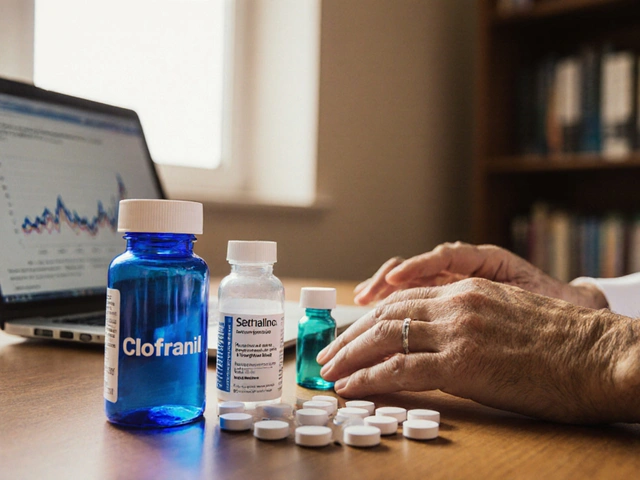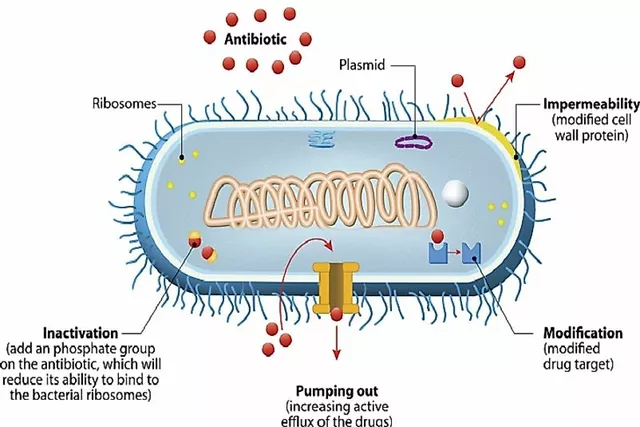Understanding Hodgkin's Disease and Its Connection to Osteoporosis
In this section, we will delve into what Hodgkin's Disease is and how it relates to the risk of developing osteoporosis. Hodgkin's Disease, also known as Hodgkin's Lymphoma, is a type of cancer that affects the lymphatic system, which is an essential part of our immune system. The lymphatic system is responsible for fighting infections and maintaining the balance of fluids in our body. When someone has Hodgkin's Disease, their body's ability to fight infections and maintain fluid balance is compromised, leading to various health problems, including an increased risk of osteoporosis. Osteoporosis is a condition characterized by weak and fragile bones, making them more susceptible to fractures.
Why Hodgkin's Disease Patients Are at Risk for Osteoporosis
There are several reasons why individuals with Hodgkin's Disease are more prone to develop osteoporosis. One of the primary factors contributing to this increased risk is the treatment for Hodgkin's Disease itself. Chemotherapy and radiation therapy, which are common treatments for this type of cancer, can have detrimental effects on bone health. These treatments can lead to a decrease in bone mineral density (BMD), which is a measure of bone strength. A lower BMD means that the bones are weaker and more likely to fracture.
Another reason why Hodgkin's Disease patients are at a higher risk for osteoporosis is that they tend to have lower levels of physical activity due to their condition. Regular physical activity, particularly weight-bearing exercises, helps maintain bone health and strength. Lack of physical activity can result in weaker bones, increasing the risk of osteoporosis.
Monitoring Bone Health in Hodgkin's Disease Patients
Given the increased risk of osteoporosis in individuals with Hodgkin's Disease, it is crucial for patients and their healthcare providers to closely monitor their bone health. This can be done through regular bone density scans, which can help determine if the patient's bone density is decreasing, and if so, how rapidly. These scans can also help healthcare providers determine the most appropriate course of action to help maintain or improve bone health.
Another important aspect of monitoring bone health in Hodgkin's Disease patients is keeping track of their calcium and vitamin D levels. Both calcium and vitamin D are essential for maintaining healthy bones, and patients may need to take supplements to ensure they are getting the recommended daily amounts of these nutrients.
Lifestyle Changes to Reduce the Risk of Osteoporosis
There are several lifestyle changes that individuals with Hodgkin's Disease can make to help reduce their risk of developing osteoporosis. Exercise, especially weight-bearing exercises, can help maintain and improve bone health. Patients should consult with their healthcare providers before starting any exercise program to ensure it is safe and appropriate for their specific needs.
Maintaining a healthy diet is also essential for bone health. Consuming foods rich in calcium and vitamin D, such as dairy products, dark leafy greens, and fatty fish, can help support strong bones. Additionally, limiting alcohol consumption and avoiding smoking can also help reduce the risk of osteoporosis.
Medications to Prevent Osteoporosis in Hodgkin's Disease Patients
In some cases, healthcare providers may recommend medications to help prevent or treat osteoporosis in individuals with Hodgkin's Disease. These medications may include bisphosphonates, which can help slow down bone loss, and hormone replacement therapy (HRT), which can help maintain bone density. However, these medications may not be suitable for all patients and should be discussed with a healthcare provider to determine the most appropriate course of action.
The Importance of Early Detection and Treatment
Early detection and treatment of osteoporosis in individuals with Hodgkin's Disease are vital to help prevent fractures and maintain overall health. Regular bone density scans and monitoring of calcium and vitamin D levels can help healthcare providers identify any potential bone health issues early on, allowing for prompt intervention and treatment. In addition to medical treatments, making lifestyle changes to support bone health can help reduce the risk of osteoporosis and its associated complications.
Living Well with Hodgkin's Disease and Osteoporosis
While the risk of osteoporosis is higher for individuals with Hodgkin's Disease, it is crucial to remember that living a healthy and fulfilling life is still possible with the right support and interventions. By working closely with their healthcare providers, patients can develop a personalized plan to monitor and maintain their bone health, reduce their risk of fractures, and improve their overall quality of life.






maya steele
Patients undergoing treatment for Hodgkin's disease should schedule baseline bone mineral density (BMD) assessments as soon as the therapeutic regimen begins. Regular dual‑energy X‑ray absorptiometry (DXA) scans enable clinicians to detect early bone loss and adjust interventions promptly. Adequate intake of calcium (1,000 mg daily) and vitamin D (800‑1,000 IU daily) is essential to support osteoblastic activity during and after chemotherapy. Moreover, integrating weight‑bearing exercise, such as brisk walking or resistance training, under supervision can markedly mitigate osteoporotic risk.
Sharon Lax
The pathophysiological cascade linking Hodgkin's lymphoma treatment to secondary osteoporotic phenomena is, frankly, an expected pharmacodynamic sequela. Cytotoxic agents precipitate osteoclastic over‑activation whilst concomitant glucocorticoid exposure accelerates mineral dysregulation. One could argue that the literature merely reiterates known iatrogenic bone demineralization without offering novel prophylactic algorithms. Nevertheless, the data underscore the necessity for clinicians to anticipate this risk factor amplification.
paulette pyla
Oh great, another post preaching the same old “exercise more, take your vitamins” mantra while ignoring the socioeconomic barriers many patients actually face. It’s almost comical that the medical community loves to bless us with generic lifestyle tips instead of tackling the structural inequities that limit access to DXA scans. If only the healthcare system would prioritize affordable bone health monitoring over endless hype.
Benjamin Cook
Stay active and get those scans ASAP!!
karthik rao
While I concur with the recommendation for periodic densitometry, it is imperative to contextualize these measures within a broader metabolic framework. Serum markers such as PTH, alkaline phosphatase, and collagen cross‑links offer adjunctive insight into bone turnover dynamics. Additionally, the selection of bisphosphonate therapy should be individualized, considering renal function and concomitant medications. 📊💊
Breanne McNitt
Thanks for the thorough overview! I’ve found that joining a community exercise group not only boosts motivation but also provides accountability for maintaining weight‑bearing activities. Pairing that with regular nutritional counseling has helped many of my friends stay on top of their calcium and vitamin D intake. Keep the practical tips coming!
Ashika Amirta varsha Balasubramanian
From a holistic perspective, the mind‑body connection plays a subtle yet pivotal role in bone health. Stress reduction techniques, such as mindfulness meditation, can lower cortisol levels, which in turn may attenuate osteoclastic activity. Cultural dietary practices rich in calcium-like traditional Indian paneer dishes-can be seamlessly integrated into post‑treatment meal plans. Embracing these culturally resonant strategies empowers patients to take ownership of their skeletal resilience.
Jacqueline von Zwehl
It is worth noting that adherence to supplementation regimens often falters due to gastrointestinal side effects. Splitting calcium doses throughout the day and choosing chelated forms can improve tolerability. Moreover, ensuring adequate protein intake supports collagen synthesis, a critical component of bone matrix. These nuanced adjustments can make a meaningful difference in long‑term outcomes.
Christopher Ellis
One might say that bone is merely a reservoir of calcium awaiting the whims of endocrine signaling. Yet, the existential weight of that metaphor reminds us that neglecting bone health reflects a deeper societal disregard for the aging body. In this light, proactive screening becomes an ethical imperative, not merely a clinical recommendation.
kathy v
When it comes to the intersection of Hodgkin's disease and osteoporosis, the conversation often gets drowned out by louder political rhetoric that marginalizes the very real suffering of patients. The data clearly show that chemotherapy and radiation diminish bone mineral density, yet some policymakers choose to prioritize funding for high‑visibility projects over essential bone health services. This is not just an oversight; it is a direct affront to the principle of equitable healthcare. The United States, with its advanced medical infrastructure, should lead by example, allocating resources to subsidize DXA scans for low‑income survivors. Ignoring this need perpetuates a cycle where only the privileged can afford preventative care. Moreover, the cultural narrative that frames osteoporosis as an inevitable consequence of aging undermines the agency of young cancer survivors who are at heightened risk. By reframing the discourse to emphasize early detection and tailored intervention, we empower patients rather than resign them to fate. It is also worth mentioning that vitamin D insufficiency remains rampant across many communities, a problem exacerbated by limited sunlight exposure in certain regions. Addressing this requires public health initiatives that go beyond the clinic walls, such as community fortification programs. The medical community must also hold itself accountable, ensuring that oncologists collaborate closely with endocrinologists to create comprehensive survivorship plans. Failure to do so not only jeopardizes bone integrity but also increases the likelihood of fractures, which carry their own morbidity and mortality. In short, the confluence of cancer treatment and bone health is a public health issue that demands coordinated, well‑funded action. Anything less is an unacceptable compromise of patient well‑being. Let us, therefore, demand policies that reflect the urgency of this matter and allocate the necessary financing to protect the skeletal health of Hodgkin's disease survivors.
Jorge Hernandez
Totally agree 🙌. Keep the bone‑friendly habits rolling and don’t forget those vitamin D gummies!
Raina Purnama
Thank you all for sharing such diverse perspectives; the collective insight will undoubtedly assist many navigating this complex survivorship journey.